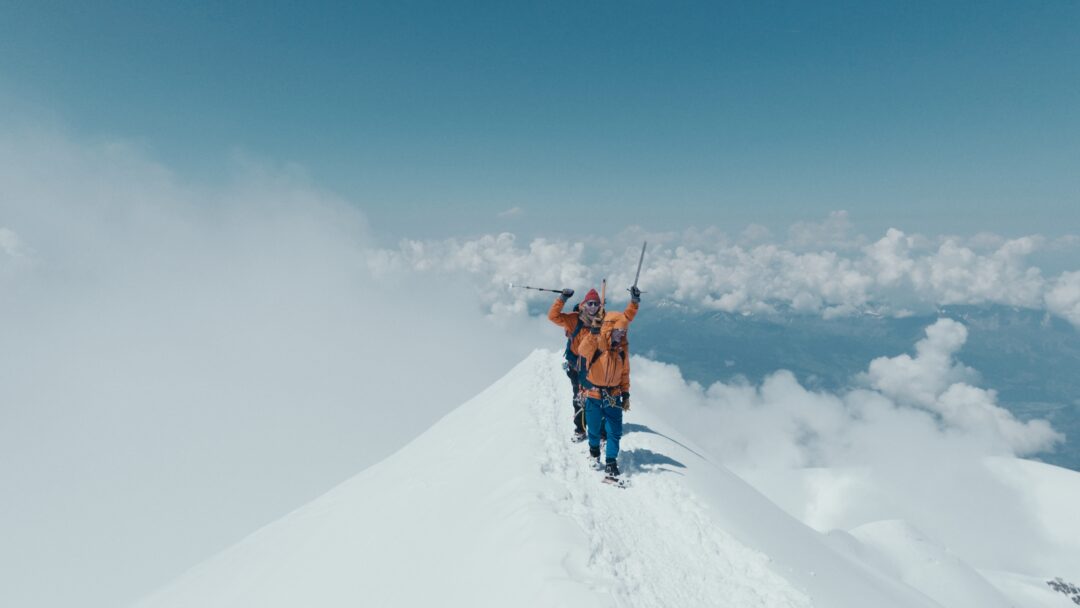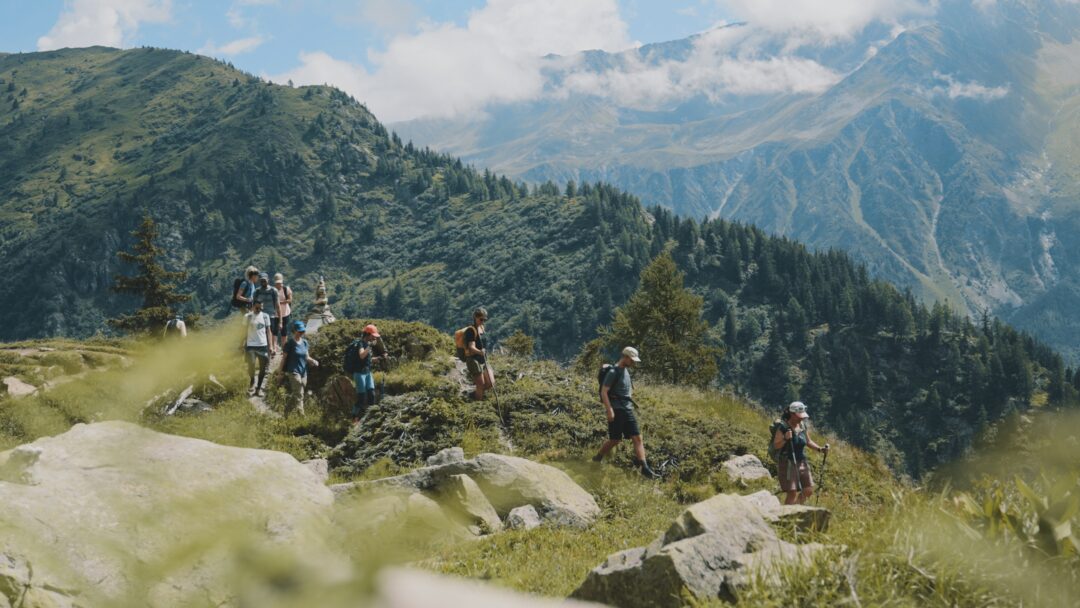If you’re new to the world of outdoor adventures, you’ve probably encountered some familiar terms that you can’t quite define, or at least not with much confidence. You may even use certain words interchangeably without realising that you’re mistaken. For example, ‘hiking’ and ‘mountain climbing’ are staples of the outdoor adventure vocabulary, but newcomers may not know how to define either or how they differ from one another.
Well, Adventure Base is here to help! From guided alpine treks to mountain climbing in the Alps, we are specialists in guiding adventurers of all levels towards their next challenge. Whether you’re taking your first steps on a scenic mountain trail or setting your sights on summiting a high-altitude peak, understanding the key differences between these activities is the first step towards progressing in your outdoor journey.
So, let’s take a closer look at the difference between hiking and mountain climbing! And if you have any questions for our team, please don’t hesitate to get in touch.
Defining Hiking vs. Mountain Climbing
Let’s start with some simple definitions:
- Hiking is a recreational activity that involves walking on marked trails, typically over rolling hills, through valleys, and along lower-altitude mountain paths. It can range from an easy half-day walk to a more challenging full-day experience, but it generally doesn’t require specialised equipment beyond sturdy footwear, weather-appropriate clothing, and basic outdoor essentials.
- Mountain climbing, also known as mountaineering, is a more technical and physically demanding activity. It involves ascending high-altitude peaks, often navigating steep, rugged terrain, and sometimes using ropes, harnesses, ice axes, and crampons. Mountain climbing demands more than just endurance — it requires technical skills, careful planning, and an ability to adapt to unpredictable conditions.
And what about ‘trekking’? This term sits somewhere in between. While hiking is more of a brisk walk through natural scenery and is often seen as easy, pleasant and jovial, the key point is that it doesn’t last longer than a day. Trekking refers to a multi-day, long-distance journey, often in remote areas, sometimes involving high-altitude passes. It’s more strenuous and challenging than regular hiking, but it doesn’t involve the technical elements of mountain climbing.
For more insights into the differences between the two, read our blogs How Easy and Accessible is Hiking Self-Guided in the Alps? and How Difficult is it to Climb Mont Blanc? when you have finished here.

Key Differences Between Hiking and Mountain Climbing
Now that we’ve defined the terms, let’s explore the key differences between hiking and mountain climbing.
Terrain and Difficulty
- Hiking trails are often well-marked and maintained, leading through forests, valleys, and mountain ridges. While some trails may have steep sections, they are generally accessible to most people with a reasonable level of fitness.
- Mountain climbing involves more challenging, often unmarked routes that require route-finding skills. Climbers may encounter glaciers, rocky ridges, and near-vertical ascents, demanding technical ability and a high level of physical strength, fitness, and endurance.
Gear and Equipment
- Hiking requires minimal gear: comfortable hiking boots, a backpack with water and snacks, a map, and weather-appropriate clothing.
- Mountain climbing demands specialised equipment such as ropes, harnesses, helmets, crampons, ice axes, and mountaineering boots. Climbers also need protective clothing to handle extreme weather conditions.
When you browse the individual experiences in our range of guided treks in the Alps and alpine summit climbs, you will find a section about the kit and equipment needed for each excursion. The details further highlight the differences; while treks are more challenging than hikes, the kit list still mostly focuses on appropriate clothing. For summit climbs, the list covers what to wear but also includes the technical equipment covered above, i.e. crampons, ice axes, etc.

Physical and Mental Demands
- Hiking requires moderate endurance and strength, but most people can build up to longer hikes and multi-day treks with practice.
- Mountain climbing demands not only peak physical conditioning but also mental resilience. Climbers must stay focused, make quick decisions, and endure physical discomfort at high altitudes.
Skills and Training
- Hiking is relatively beginner-friendly. While navigation and basic first aid knowledge are helpful, they aren’t essential for most well-marked trails.
- Mountain climbing requires technical training, including rope work, glacier travel, ice climbing, and crevasse rescue techniques. Many climbers start by taking courses or joining guided climbs.
Risks and Safety Considerations
- Hiking has fewer risks, though factors like sudden weather changes, dehydration, and injuries from falls can still occur.
- Mountain climbing carries greater risks, including altitude sickness, avalanches, falling rocks, and extreme weather. Climbers need to be well-prepared and experienced in managing emergencies.
Our blog What’s it Like Climbing The Matterhorn? is another essential read filled with expert insights into the realities of summit climbing. But if you’re still very much at the start of your adventuring journey, our guide to planning your first alpine trip is ideal for beginners.

Progressing from Hiking to Mountain Climbing
If you love hiking and are eager to take on greater challenges, mountain climbing might be the next step in your adventure journey. Here’s how you can progress:
- Tackle More Challenging Hikes and Treks: Build endurance by taking on longer, steeper trails and multi-day treks.
- Improve Your Navigation and Outdoor Skills: Learn how to read maps, use a compass, and understand mountain weather patterns.
- Take an Introductory Mountaineering Course: Learn essential climbing techniques, ropework, and glacier travel skills. Our Chamonix: Winter Alpine Skills course is the perfect way to develop under expert guidance.
- Train Physically: Strengthen your legs, core, and cardiovascular endurance to handle the demands of mountaineering.
- Join a Guided Climb: The best way to transition from hiking to mountain climbing is with expert guidance. At Adventure Base, we offer guided alpine peak climbs, perfect for those looking to make the leap from hiking to the high mountains.

Embrace Adventure with Our Guided Treks and Summit Climbs in the Alps
Whether you’re an enthusiastic hiker or an aspiring mountaineer, the Alps offer some of the world’s most breathtaking landscapes and thrilling challenges. At Adventure Base, we specialise in guided hikes and mountain climbs designed to help adventurers of all levels push their limits safely and confidently.
Let’s finish with some specific recommendations. If you’ve got a few long hikes under your belt, consider our 11-Day Tour du Mont Blanc Guided Hike — it’s not the easiest-going option, but it doesn’t throw you into the deep end either.
Looking to take on your first mountain climb? Our Triglav climb and Monte Rosa spaghetti tour are great gateways to this physically and mentally demanding world.
Please don’t hesitate to contact us if you have any questions about our alpine experiences!

